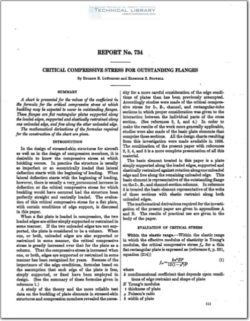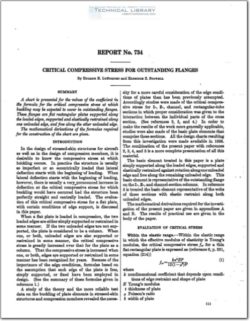NACA-REPORT-734

- Version
- 464 Downloads
- 752.86 KB File Size
- 1 File Count
- March 23, 2016 Create Date
- March 23, 2016 Last Updated
National Advisory Committee for Aeronautics, Technical Notes - Critical Compressive Stress for Outstanding Flanges

A chart is presented for the-values qf the coefiicient in
the formula for the critical compressive stress at which
buckling may be expected to occur in outstanding flanges.
These flanges are flat rectangular plates supported along
the loaded edges, supported and elastically restrained along
one unloaded edge, and free along the other unloaded edge.
The mathematical derivations of the formulas required
for the construction of the chart are given.
In the design of strased-skin structures for aircraft
as well as in the design of compression members, it is
desirable to know the compressive strens at which
buckling occurs. In practice the structure is usually
so imperfect or so eccentrically loaded that lateral
deflection starts with the beginning'of loading. When
lateral deflection starts with the beginning of loading,
however, there is usually a vernpronounced increase in
deflection at the critical compressive stress for which
buckling would have occurred had the structure been
perfectly straight and centrally loaded. The evalua-
tion of this critical compressive stress for a flat plate,
with certain conditions of edge support, is discussed
in this paper.
When a flat plate is loaded in compression, the two
loaded edges are either simply supported or restrained in
some manner. If the two unloaded edges are not sup-
ported, the plate is considered to be a column. When
one, or both, unloaded edges are also supported or
restrained in some manner, the critical compressive
stress is greatly increased over that for the plate as a
column. That the compressive stress is increased when
one, or both, edges are supported or restrained in some
manner has been recognized for years. Because of the
importance of the edge conditions, formulas based on
the assumption that each edge of the plate is free,
simply supported, or fixed have been employed in
design. (See the summary of these formulas given in
reference 1.)
| File | Action |
|---|---|
| naca-report-734 Critical Compressive Stress for Outstanding Flanges.pdf | Download |

Comment On This Post